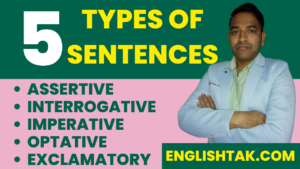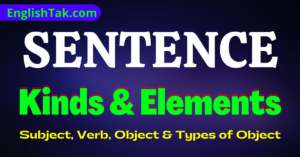![]()
Parts of a Sentence in English
Table of Contents
Parts of a Sentence in English:– Every sentence needs a subject and a predicate. This is the fundamental rule of any sentence.
In other words, when we name a person or a thing, this is subject and when we say something about a subject or refer to the subject for anything, this is a predicate.
This relation is altogether known as subject-predicate which is the core of any complete sentence. Let’s look at them more elaborately.
Join Our Telegram Group
प्रत्येक वाक्य को एक सब्जेक्ट और एक विधेय की आवश्यकता होती है। यह किसी भी वाक्य का मूल नियम है।
दूसरे शब्दों में, जब हम किसी व्यक्ति या वस्तु का नाम लेते हैं, तो यह सब्जेक्ट होता है, और जब हम किसी सब्जेक्ट के बारे में कुछ कहते हैं या किसी सब्जेक्ट के बारे में कुछ कहते हैं, तो यह एक विधेय होता है।
इस संबंध को कुल मिलाकर सब्जेक्ट-विधेय के रूप में जाना जाता है, जो किसी भी पूर्ण वाक्य का मूल होता है। आइए उन्हें और अधिक विस्तार से देखें।
Parts of Sentence
SUBJECT:
This is one of the most important aspects of a sentence. In other words, you can say, this is the leader of any sentence. A sentence cannot be complete or will be meaningless if it does not have a subject of its own.
यह एक वाक्य के सबसे महत्वपूर्ण पहलुओं में से एक है। दूसरे शब्दों में, आप कह सकते हैं, यह किसी भी वाक्य का नेता है। एक वाक्य पूर्ण नहीं हो सकता है या अर्थहीन होगा यदि उसका अपना कोई सब्जेक्ट नहीं है।
“I saw a cow on the field“.
Here “I” is the subject as it leads the sentence. If I remove it, it will have no meaning nor it will be grammatically correct.
“A cow saw me on the field“.
Here the subject changes to “a cow”. Usually, a subject sits at the beginning of a sentence. However, there are exceptions.
“Here comes John“.
In this case, “John” is a subject as it leads the sentence and without John, the sentence will become orphan.
“Gone are the days, when…….“.
“The days” is the subject in this sentence even though it starts with a verb “gone” (past participle form). Why so? It can be said otherwise, “The days are gone when….” Hence, wherever, we place a subject, it always leads a sentence.
To sum up, I would say, the subject is the head of any sentence and we need it to make a sentence start, at the least.
PREDICATE:
In simple words, the predicate in English refers to the part of a sentence that contains the verb and provides information about the subject. It describes the action or state of being expressed by the subject.
The predicate typically consists of the main verb along with other elements such as objects, complements, adverbs, or modifiers that give more details about the action or state. It helps to complete the meaning of the sentence and provides information about what the subject is doing or what is being said about the subject.
Here are a few examples to illustrate the predicate:
1. The cat is sleeping.
– Subject: The cat
– Predicate: is sleeping
2. She plays the piano beautifully.
– Subject: She
– Predicate: plays the piano beautifully
3. They have finished their homework.
– Subject: They
– Predicate: have finished their homework
In these examples, the predicates “is sleeping,” “plays the piano beautifully,” and “have finished their homework” provide information about what the subjects (the cat, she, they) are doing or their state of being.
Remember, the predicate is an essential part of a sentence and works together with the subject to convey complete thoughts or statements.
OBJECT
In simple words, an object in English refers to a noun, pronoun, or noun phrase that receives the action of a verb or is the recipient of the verb’s action. It provides more information about what or whom the action of the verb is directed towards.
सरल शब्दों में, अंग्रेज़ी में Object का अर्थ एक संज्ञा, सर्वनाम या संज्ञा वाक्यांश होता है जो क्रिया के कार्रवाई को प्राप्त करता है या क्रिया की कार्रवाई का प्राप्तकर्ता होता है। यह क्रिया की कार्रवाई किस वस्तु या किसके प्रति होती है, इसके बारे में अधिक जानकारी प्रदान करता है।
Parts of a Sentence in English
There are two types of objects in English: Direct objects and indirect objects.
1. Direct Object:
A direct object is the noun, pronoun, or noun phrase that directly receives the action of the verb. It answers the question “Whom?” or “What?” after the verb.
Note:- When there is only Object in a sentence, that is always Direct Object.
Example:
– Rohan kicked the ball.
– In this sentence, “the ball” is the direct object as it receives the action of the verb “kicked.” It answers the question “What did John Rohan?”
2. Indirect Object:
An indirect object is the noun, pronoun, or noun phrase that indicates to whom or for whom the action of the verb is done. It usually appears between the verb and the direct object and answers the question “To whom?” or “For whom?”
Example:
– John gave Mary a gift.
– In this sentence, “Mary” is the indirect object as she receives the gift. It answers the question “To whom did John give the gift?”
It’s important to note that not all sentences have an indirect object, and some verbs may not take an object at all. Objects play a crucial role in providing more information about the action and recipients involved in a sentence.
English Grammar & Vocabulary
Common Adjectives with Letter E
Talking about favourite Restaurant





